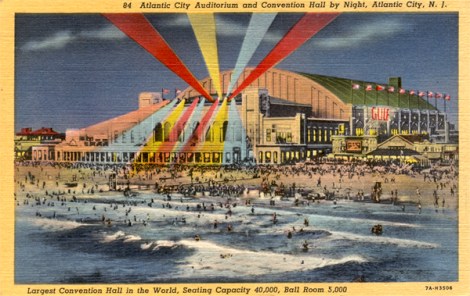
kitchener.lordParty time in Atlantic City, at least until it joins Atlantis.
Environmental organizations — even big, established ones — move with the times. Preserving wilderness becomes concern over toxics becomes protecting big-eyed species becomes obsession over the Amazon rainforest. (I’m sure I’m missing a few steps in there.)
Today, they’re moving into the next phase — applying climate change science to the question of how to take care of the landscapes of the future.
Jeff Tittel, the outspoken director of the New Jersey Sierra Club, exemplifies these shifts. In the years he’s been director he’s worked on water issues, regulation of suburban sprawl, and restrictions on auto emissions. Now he works on flood insurance — on the grounds that the way things are going, the landscapes we’re trying to save aren’t likely to stay put.
Q. So you’re director of the Sierra Club in New Jersey. Why so interested in flood insurance? It doesn’t jibe with my image of what the Sierra Club does.
A. It has to do with New Jersey being clobbered by Hurricane Sandy. Really, we got clobbered. Because of the Stafford Act, we keep on subsidizing building in the wrong places. The Biggert-Waters Act would change that, but it’s getting weakened, even by our elected officials who are good on climate change. They’re folding under constituent pressure. Our concern is that they’re going to block these insurance increases and not make any changes, and that will put even more people in harm’s way.
We don’t have any time. People are rebuilding right now in velocity zones. They cut ribbons on the old boardwalks, in the same place, without even dunes in front of them.
Q. Were there dunes there before the hurricane?
A. No. They were all flattened a long time ago. But instead of fixing the problems of the past we’re trying to extend those problems into the future.
And right now the state EPA can’t even mention climate change. The irony is that we were one of the first states to have plans in place for climate change mitigation and adaptation.
Q. When was that?
A. The ’90s. And then we had most of it in place from 2005 on. And then Chris Christie was elected governor.
Q. Why do you think New Jersey was so ahead of the curve in the ’90s?
A. We have some of the leading climate change scientists in the country, like Oppenheimer at Princeton and Broccoli at Rutgers. Also, we flood. We flood a lot. We have land subsidence in New Jersey [PDF]. We’re sinking. You can just see the storm levels rise here. Go out to Long Beach Island or Mystic Island at high tide and the storm drains that were put in 50 years ago well above the tide line are completely underwater.
The New Jersey Fish and Wildlife Service has been buying upland areas to reestablish wetlands when the seas rise, because the wetlands we have are going to disappear and they’re on the international flyway — a major bird stopover. We lost three football fields worth of coastal marshes on the Delaware Bay in the last few years.
To really mitigate and adapt for climate change will take 50 years. We have to buy out, elevate, and harden. Atlantic City will either have to harden, or no one will be living on the ground. Soon enough, the Giants aren’t going to be playing the Miami Dolphins. They’re going be playing actual dolphins.
Hurricane Sandy was a wake-up call. More so than Katrina, because the Gulf would always get hurricanes. But Sandy would have normally gone northeast, except that the high-pressure system created by melting sea ice between North America and Greenland sent it to us. And the years before that were Hurricane Irene and Hurricane Lee. If the system holds, New Jersey is now hurricane country, like Miami and New Orleans. This October was the first in three years that Halloween wasn’t cancelled.
Q. When did you first learn about climate change?
A. I’m one of those old-time environmentalists. Back when I was a kid we called it the greenhouse effect. Both my parents were Sierra Club members.
Q. And when did you get involved in politics?
A. I was in the seventh grade. It was the first Earth Day in our town. I organized all the other seventh graders to go clean up the river, but we didn’t have any trucks and rakes to do it. So I went to the Democratic county chair. I asked them, “Can we borrow some trucks and rakes?”
“Will the media be there?” said the chair. “Yes,” I said.
“Well, then can the mayor come and get his picture taken with you?”
“Of course,” I said. And that is how we got our trucks and rakes.
Some people like to say that they’re non-political. But I say that being non-political is political, and bad politics. I keep seeing these bumper stickers that say, “Stronger than the Storm.”
You know what? We’re never going to be stronger than the storm. I want to make a bumper sticker and put a dinosaur on it with the word ‘strong’ next to it. The key to evolution is not ‘Who is strong?’ The key to evolution is ‘Who can adapt?’


